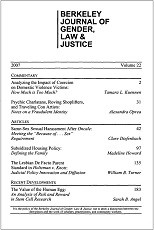Judith F Daar

Extract
Conclusion
The constitutional jurisprudence surrounding assisted conception is only beginning to take shape . . . . When conception occurs naturally, both positive and negative rights surrounding procreation are fairly clear, but grow murky as the reproductive process invites third parties to assist. As methods of assisted conception show increasing technological promise for those whose physical characteristics, social status, or both require they look to ART for family formation, worrisome trends suggest that third party actors are quietly mounting status-based barriers to fertility treatment. Barriers to ART are taking shape on the basis of patient characteristics including wealth, race, ethnicity, sexual orientation, and marital status, all under the guise of preventing harm to offspring and society at large. However, judgments by ART providers and public lawmakers that certain individuals will be unfit parents, veer dangerously close to the coercive eugenics practices of early twentieth century America, practices whose only positive legacy is the extreme caution with which we now approach state-sponsored limitations on reproduction.
Like a pentimento, ART barriers are only beginning to come into view from the experiences of an increasingly diverse and nontraditional reproductive medicine patient population. As each barrier emerges-whether it be a provider refusing treatment to a single or gay or lesbian prospective parent, or a lawmaker attempting to limit the availability of a reproductive technology for reasons unrelated to human health-it is essential to evaluate these actions by the same standards we would evaluate barriers to natural conception. . . . State-sponsored or state-approved limitations on any individual’s right to procreate simply cannot stand in a society that acknowledges the preeminence of reproductive freedom. Justice Douglas’ selfevident observation that reproduction is a basic human right is as durable and universal as the human race-it simply must be nurtured in order to continue to thrive.
Daar JF. Accessing Reproductive Technologies: Invisible Barriers, Indelible Harms. Berkeley J Gender Law Just. 2008 Mar;23(1):18-82.